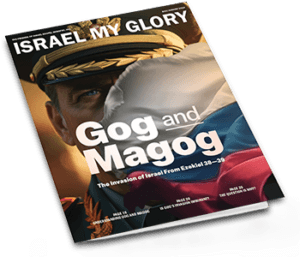Will Russia Soon Fulfill the Prophecy of Gog and Magog?
As a Polish citizen whose wife is from the Ukrainian city of Donetsk, I have a unique perspective on the Russia-Ukraine war. I saw the panic in Poland when Russian troops entered Ukraine. Some stockpiled supplies and fuel. Others prepared to leave the country, anticipating that Poland would be invaded next.
Despite unresolved trauma from the 1943—1944 Volhynia Massacre in which Ukrainian nationalists killed tens of thousands of Polish people, Poland opened its borders to more than 1 million Ukrainian refugees escaping the war. After all, Poland remembers Russian forces invading and ruling Polish lands, first as the Russian Empire and later as the Soviet Union after World War II. Jewish people numbered among the thousands of Ukrainians who escaped when Russia entered Ukraine. The Friends of Israel’s representatives in Poland helped many of them leave Ukraine, provided shelter, and oversaw their departure to Israel.
Major Recent Developments From the Russia-Ukraine War
The Western public has grown indifferent to and tired of the war in Ukraine, but on August 6, we witnessed something unseen since World War II. Russia, the world’s largest country, lost territory to the much smaller and weaker Ukraine, which invaded Russia’s Kursk region.
As a nuclear power, Russia’s weakness against a smaller country encourages the Ukrainians to continue fighting. But, Ukraine is humiliating a nation with the potential to end this world. A few days after Ukraine’s attack, a fire erupted at Ukraine’s Zaporizhzhia nuclear power plant. Russia had controlled Europe’s largest nuclear power plant for more than two years, and although it denies causing the fire, the message was clear.
Israel, Russia, Ukraine, and Iran
Israel’s relationships with these warring nations are complex. The State of Israel’s creation was aided by strong Soviet advocacy. On November 29, 1947, the Soviet Union voted in favor of the 1947 United Nations Partition Plan for Palestine, which opened the doors for a Jewish state. Joseph Stalin adopted a pro-Zionist foreign policy, seemingly convinced that the new nation would be socialist and reduce British influence in the Middle East. While the United States first recognized Israel de facto upon Israel’s declaration of independence on May 14, 1948, the Soviet Union was the first nation to extend de jure recognition to the newly established Jewish state three days later. However, during the Suez Canal Crisis in 1957, the Soviet Union, stripped of its socialist dreams for this new country, began supporting the Arab states against Israel.
During the Soviet Union’s collapse, Israel saw one of its most significant aliyot (Jewish immigration) from former Soviet countries. Between 1989 and 2018, about 1.7 million Soviet Jews and their relatives left for Israel, transforming parts of Jewish cities into Russian neighborhoods. People spoke Russian, had Russian stores selling kielbasa, and watched Russian television. Many Israeli citizens felt a connection to these lands where they or their parents were born.
When the war in Ukraine started, Israel carefully supported Ukraine. Israel understood the pain of a foreign power’s rocket attacks but could not underestimate Russia’s influence in the Middle East. Openly supporting Ukraine could trigger Russia’s S-400 air defense systems stationed in Syria against Israeli planes patrolling the region.
Although Israel is still hesitant to enter full-blown conflict with Russia, Russia has chosen its side, evidenced by its invitation of Hamas leaders.
Iran’s weapons sale to Russia strained Russia and Israel’s relationship. Israel has been concerned about Iran and Russia’s increased military cooperation, mainly through arms deals and potential joint defense initiatives. The war in Ukraine exposed that Russia must obtain weapons from Iran. Russia understood this would be unacceptable in Israel, clearly indicating that Putin is not afraid to antagonize the two states completely. Although Israel is hesitant to enter full-blown conflict with Russia, Russia has chosen its side, evidenced by its invitation of Hamas leaders to Moscow on October 26, 2023.
The Prophetic Perspective
Israel and Russia’s conflict may be linked to biblical prophecy. The prophet Ezekiel described the confederation of nations led by “Gog, of the land of Magog, the prince of Rosh, Meshech, and Tubal” (v. 2). Some terminology used in Ezekiel 38 is seen in the table of nations (Genesis 10). Magog, Tubal, and Meshech are descendants of Japheth (v. 2). In The Harvest Handbook of Bible Prophecy, Mark Hitchcock argues that the Indo-European race descended from Japheth, and the three regions mentioned in Ezekiel 38 (Magog, Tubal, and Meshech) refer to the territories of today’s southern Russia, Ukraine, and Turkey. Magog and Rosh, likely the same territory of southern Russia, are elevated to leadership in their charge against Israel. The main attack will come from a remote nation in the North (Ezekiel 38:6; 39:2, 15). There is no more remote nation north of Israel than Russia.
On September 30, 2015, Russia launched a military intervention in Syria after a request by Syrian President Bashar al-Assad’s government, allowing Russia to play an important role in the Near East. And the war in Ukraine, which began with Russia’s invasion in February 2022, has drawn Russia and Iran closer in several strategic and economic areas.
We may imagine giant armies from Russia, Iran, Turkey, and many Arab nations, but Israel’s assurance of victory is in the God of Israel.
It is unknown if Russia and Ukraine’s conflict will lead to this giant attack on Israel from the land of Rosh, but we know God is regathering His people, Israel, in the land. Ezekiel 37 was fulfilled when the State of Israel was born “in one day” (Isaiah 66:8). Ezekiel 38 and 39 come next. We may imagine giant armies from Russia, Iran, Turkey, and many Arab nations, but Israel’s assurance of victory is in the God of Israel. He will destroy its enemies (38:19–22), beginning a new era when Christ will return with His church to rule for 1,000 years in Jerusalem (Revelation 20).
Photo Credit: Adobe Stock
